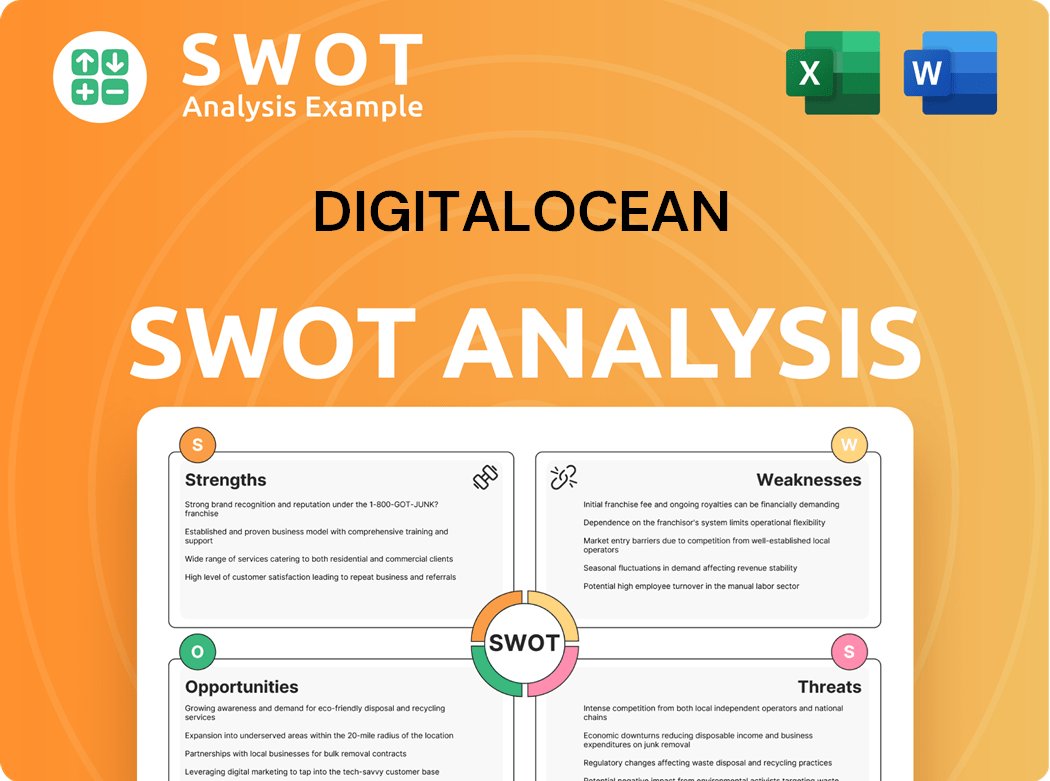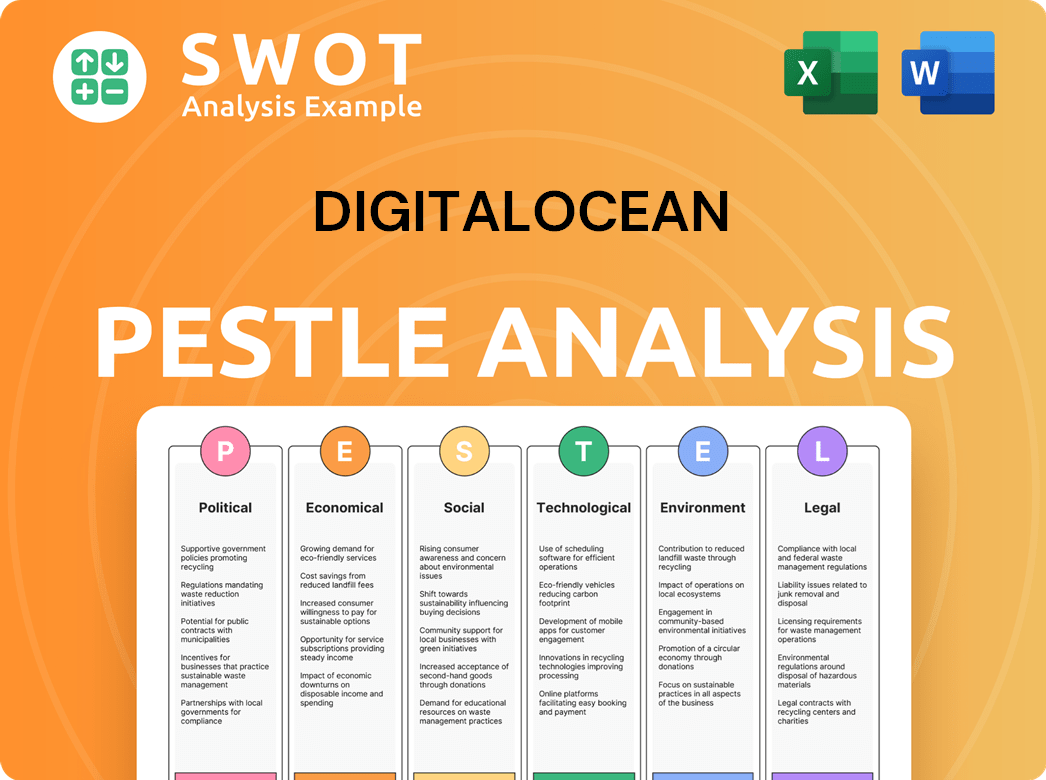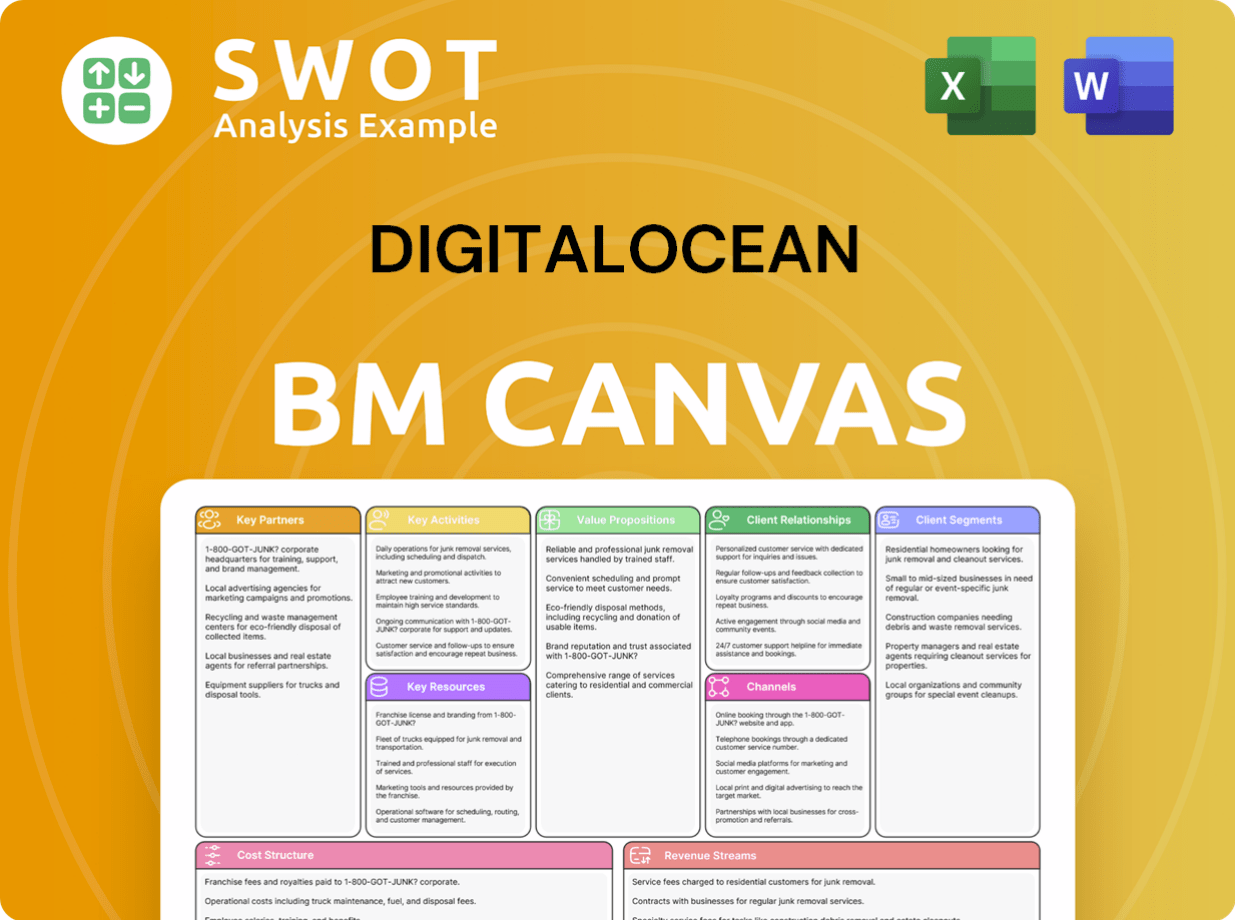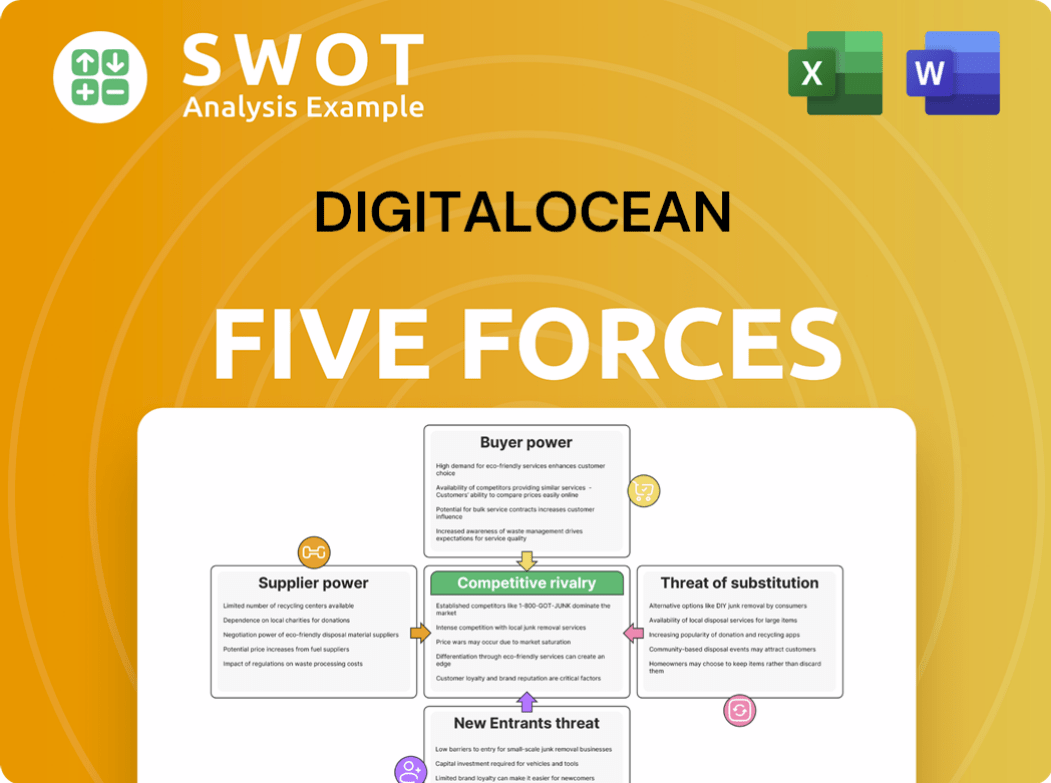DigitalOcean Bundle
Who are DigitalOcean's Ideal Customers?
Unveiling the customer demographics and target market of DigitalOcean is key to understanding its remarkable journey in the cloud computing arena. From its inception, DigitalOcean has focused on providing accessible cloud solutions, but who exactly are the individuals and businesses that power its success? This analysis dives deep into the DigitalOcean SWOT Analysis to explore the evolving customer profile.

Understanding the DigitalOcean customer profile, including their tech skills and business size, is crucial for anyone looking to leverage cloud computing. This exploration of DigitalOcean's target market will examine its primary customer base, including developers, SMBs, and startups, and analyze their needs and behaviors. We will also explore how DigitalOcean's customer acquisition strategy has evolved to meet the demands of its growing user base and the competitive landscape.
Who Are DigitalOcean’s Main Customers?
Analyzing the customer base of DigitalOcean, it's clear that they primarily serve a Business-to-Business (B2B) market. The core focus is on developers, startups, and small to medium-sized businesses (SMBs). The platform's ease of use and scalability are key factors in attracting these groups.
While specific demographic details like age, gender, and income levels of individual users aren't widely available, the customer profile generally consists of technically skilled individuals and small teams. These users require accessible and efficient cloud infrastructure solutions. This includes web developers, software engineers, entrepreneurs, and IT professionals who value simplicity, affordability, and performance.
The majority of DigitalOcean's revenue and the fastest growth typically originate from startups and SMBs. These businesses often lack the extensive IT resources or budgets of larger corporations. This makes DigitalOcean's simplified cloud solutions highly attractive. For example, in 2024, the demand from SMBs for agile and cost-effective cloud solutions continued to be a significant driver for companies like DigitalOcean. Over time, there has been a shift from individual developers to a more diversified base, including growing businesses. This shift has been prompted by DigitalOcean's expansion of its product offerings beyond basic virtual machines to include managed databases, Kubernetes, and serverless functions, catering to the increasing sophistication of its target market.
The primary DigitalOcean customer profile includes developers, startups, and SMBs. These customers are typically technically proficient individuals and small teams. They require scalable and easy-to-use cloud infrastructure.
The DigitalOcean target market focuses on businesses that value simplicity and affordability. They often lack the resources of larger companies. The platform offers a simplified approach to cloud management.
DigitalOcean's customer base is segmented based on business size and technical expertise. Startups and SMBs are key segments. The platform caters to a range of technical skill levels.
The DigitalOcean customer acquisition strategy focuses on ease of use and value. They provide accessible cloud solutions. They also focus on developer communities and online marketing.
The ideal DigitalOcean customer profile includes developers, engineers, and IT professionals. These customers seek affordable and easy-to-manage cloud solutions. They often come from startups and SMBs.
- Technically proficient individuals.
- Businesses looking for cost-effective solutions.
- Customers prioritizing ease of use and scalability.
- Companies in the early to mid-stages of development.
DigitalOcean SWOT Analysis
- Complete SWOT Breakdown
- Fully Customizable
- Editable in Excel & Word
- Professional Formatting
- Investor-Ready Format

What Do DigitalOcean’s Customers Want?
Understanding the needs and preferences of DigitalOcean's customers is crucial for tailoring services and marketing efforts effectively. The company's success hinges on its ability to meet the demands of its target market by providing solutions that are simple, affordable, and scalable. Analyzing the customer base reveals insights into their motivations, behaviors, and the factors influencing their decisions.
DigitalOcean's customer base is primarily driven by a need for straightforward, cost-effective, and high-performing cloud solutions. Customers often prioritize ease of use, transparent pricing, and reliable infrastructure when selecting a cloud provider. This focus on simplicity and affordability is a key differentiator for DigitalOcean, attracting developers and businesses seeking to minimize operational overhead and accelerate development cycles.
The customer base of DigitalOcean is diverse, encompassing various industries and business sizes, all united by a common need for accessible and efficient cloud services. The company's approach to customer acquisition and retention is heavily influenced by understanding these core needs and preferences. By focusing on these factors, DigitalOcean can maintain a competitive edge in the cloud computing market.
Customers value simplicity, affordability, scalability, and performance. They seek solutions that are easy to deploy and manage.
Influenced by ease of deployment, intuitive user interface, transparent pricing, and reliable infrastructure. Decision-making is often driven by cost-effectiveness.
Prioritize reducing operational overhead, accelerating development cycles, and ensuring application availability. Focus on predictable billing.
Customers use DigitalOcean for hosting web applications, deploying APIs, managing databases, and setting up development and staging environments.
Customers desire control and autonomy over their infrastructure and prefer straightforward solutions. They appreciate the sense of community support.
Cost-effectiveness, predictable billing, and the ability to scale resources up or down as needed are key. Customers seek to avoid unexpected costs.
DigitalOcean addresses common pain points such as the steep learning curve associated with other cloud providers and the complexity of managing infrastructure. Customer feedback and market trends, such as the increasing demand for managed services and containerization, have directly influenced DigitalOcean's product development. For instance, DigitalOcean has expanded its offerings to include managed databases and Kubernetes services. The company tailors its marketing through developer-focused content, tutorials, and community engagement, while product features emphasize ease of use and developer-centric tools. The intuitive control panel and extensive documentation are designed to cater to the preferences of its target audience. For a deeper dive into how DigitalOcean approaches its marketing, check out the Marketing Strategy of DigitalOcean.
DigitalOcean provides a range of features designed to meet the needs of its target market, focusing on ease of use and developer-centric tools. These features are crucial for attracting and retaining customers in the competitive cloud computing market.
- Intuitive Control Panel: Simplifies infrastructure management, reducing the learning curve for new users.
- Extensive Documentation: Provides comprehensive guides and tutorials, supporting developers at every stage.
- Transparent Pricing: Offers predictable billing, eliminating surprises and allowing for better cost management.
- Scalability: Enables users to easily scale resources up or down, adapting to changing demands.
- Managed Services: Includes managed databases and Kubernetes, simplifying complex tasks and reducing operational overhead.
DigitalOcean PESTLE Analysis
- Covers All 6 PESTLE Categories
- No Research Needed – Save Hours of Work
- Built by Experts, Trusted by Consultants
- Instant Download, Ready to Use
- 100% Editable, Fully Customizable

Where does DigitalOcean operate?
DigitalOcean's geographical market presence is extensive, serving a global customer base. While specific market share breakdowns by country are not publicly available, the company's reach spans across numerous regions. Its major markets include North America and Europe, where there is a high concentration of developers, startups, and SMBs.
The company's global strategy involves adapting to the specific needs of each region. DigitalOcean operates data centers in strategic locations worldwide, including New York City, San Francisco, London, Amsterdam, Frankfurt, Bangalore, and Singapore. This allows for low latency and adherence to regional data residency requirements. The company continuously evaluates demand in new and existing markets to optimize data center locations and improve service delivery.
DigitalOcean's commitment to a global presence is evident in its data center locations and localized marketing efforts. The company's focus on SMBs and developers, combined with its accessible cloud infrastructure, positions it well in various markets. For a broader understanding of the competitive landscape, you can explore the Competitors Landscape of DigitalOcean.
North America is a key market for DigitalOcean, driven by a strong tech ecosystem. The region's high concentration of developers, startups, and SMBs aligns well with DigitalOcean's target market. This market benefits from DigitalOcean's ease of use and cost-effectiveness.
Europe represents another significant market, with a growing demand for cloud services. DigitalOcean's data centers in London, Amsterdam, and Frankfurt cater to the region's needs. The focus is on providing reliable and compliant cloud solutions.
DigitalOcean is expanding its presence in the Asia-Pacific region. Data centers in Bangalore and Singapore support this growth. The company tailors its offerings to meet the specific needs of developers and SMBs in this dynamic market.
DigitalOcean is also exploring opportunities in other emerging markets. The company's global strategy includes continuous evaluation of new markets. This expansion is driven by the increasing adoption of cloud technologies worldwide.
DigitalOcean Business Model Canvas
- Complete 9-Block Business Model Canvas
- Effortlessly Communicate Your Business Strategy
- Investor-Ready BMC Format
- 100% Editable and Customizable
- Clear and Structured Layout

How Does DigitalOcean Win & Keep Customers?
DigitalOcean's approach to customer acquisition and retention is multifaceted, focusing on attracting and keeping users through various marketing and service strategies. The company leverages digital marketing, including content marketing, SEO, and targeted advertising, to reach its DigitalOcean target market. Social media engagement, particularly on platforms frequented by developers, also plays a key role in expanding its user base.
The company benefits significantly from word-of-mouth referrals within the developer community, driven by its reputation for simplicity and reliability. DigitalOcean employs a self-service model for sales, allowing users to easily sign up and deploy resources independently. This approach is complemented by sales teams that cater to larger small and medium-sized businesses (SMBs) and growing startups, providing tailored support and solutions to meet their specific needs.
Customer retention is fostered through personalized experiences, consistent product improvements, and responsive customer support. DigitalOcean utilizes customer data and feedback to inform product development and refine its marketing messages. CRM systems are used to manage customer interactions and segment users for targeted campaigns, ensuring relevant communication and offers. For more details on how the company operates, see this article: Revenue Streams & Business Model of DigitalOcean.
DigitalOcean uses content marketing through its extensive tutorial library to attract and educate developers. SEO is employed to improve search engine rankings and increase visibility. Targeted online advertising helps reach specific segments within the DigitalOcean customer profile.
The self-service model allows users to easily sign up and deploy resources independently. This approach reduces friction and makes it easy for developers to get started. It is a key factor in the company's DigitalOcean customer acquisition strategy.
DigitalOcean places a strong emphasis on customer support to ensure user satisfaction. Customer feedback is actively collected and used to inform product development. Responsive customer support helps retain users and build loyalty.
Regular product updates and improvements are crucial for retaining customers. Community forums and educational resources help users maximize their use of the platform. These initiatives support DigitalOcean users in their projects.
DigitalOcean uses content marketing, SEO, and targeted online advertising. Social media, especially on developer-focused platforms, is also important. Word-of-mouth referrals are a significant acquisition channel.
Retention efforts include personalized experiences, product improvements, and responsive customer support. Customer data and feedback are used to refine marketing and product development. CRM systems help manage interactions.
The self-service model is the primary sales approach, simplifying the onboarding process. Sales teams provide tailored support for larger SMBs and growing startups. This dual approach caters to various customer needs.
Competitive pricing and developer-friendly tools are key acquisition drivers. Robust infrastructure and a focus on simplicity are also key. These advantages help attract and retain customers.
DigitalOcean emphasizes supporting the growth of its existing customer base. Expanding managed services and offering solutions for complex needs is a priority. This approach reduces churn and increases loyalty.
Regular product updates and community forums enhance the user experience. Educational resources help customers maximize platform usage. These initiatives contribute to customer satisfaction.
DigitalOcean Porter's Five Forces Analysis
- Covers All 5 Competitive Forces in Detail
- Structured for Consultants, Students, and Founders
- 100% Editable in Microsoft Word & Excel
- Instant Digital Download – Use Immediately
- Compatible with Mac & PC – Fully Unlocked

Related Blogs
- What are Mission Vision & Core Values of DigitalOcean Company?
- What is Competitive Landscape of DigitalOcean Company?
- What is Growth Strategy and Future Prospects of DigitalOcean Company?
- How Does DigitalOcean Company Work?
- What is Sales and Marketing Strategy of DigitalOcean Company?
- What is Brief History of DigitalOcean Company?
- Who Owns DigitalOcean Company?
Disclaimer
All information, articles, and product details provided on this website are for general informational and educational purposes only. We do not claim any ownership over, nor do we intend to infringe upon, any trademarks, copyrights, logos, brand names, or other intellectual property mentioned or depicted on this site. Such intellectual property remains the property of its respective owners, and any references here are made solely for identification or informational purposes, without implying any affiliation, endorsement, or partnership.
We make no representations or warranties, express or implied, regarding the accuracy, completeness, or suitability of any content or products presented. Nothing on this website should be construed as legal, tax, investment, financial, medical, or other professional advice. In addition, no part of this site—including articles or product references—constitutes a solicitation, recommendation, endorsement, advertisement, or offer to buy or sell any securities, franchises, or other financial instruments, particularly in jurisdictions where such activity would be unlawful.
All content is of a general nature and may not address the specific circumstances of any individual or entity. It is not a substitute for professional advice or services. Any actions you take based on the information provided here are strictly at your own risk. You accept full responsibility for any decisions or outcomes arising from your use of this website and agree to release us from any liability in connection with your use of, or reliance upon, the content or products found herein.